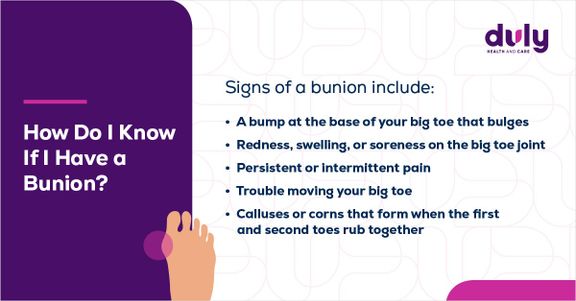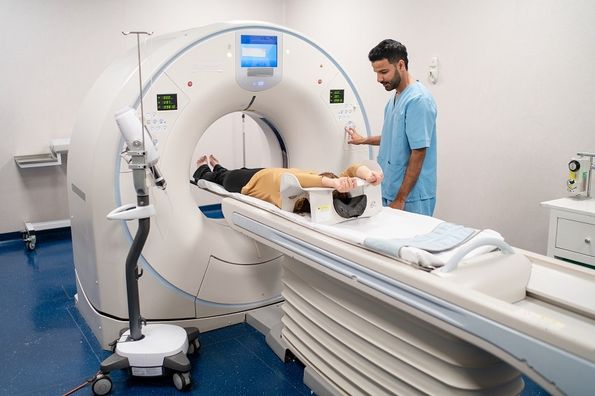Your feet are an intricate part of your body. With an impressive 56 bones, 66 joints, and hundreds of muscles, ligaments, and tendons, your feet allow you to move around and bear the weight of the rest of your body.
With all these joints and bones, it’s no wonder that things can sometimes go wrong, including the development of bunions.
A bunion is a bump on the side of the great toe joint. They form when bones in the front area of your foot move, causing your big toe to point inward toward the smaller toes. This makes the joint at the base of your big toe stick out, sometimes causing redness and soreness over the skin. The same process can occur at the base of your little toe, called a bunionette.
How Do I Know If I Have a Bunion?

Bunions are common, affecting up to one-third of people in the US. Still, there are plenty of misconceptions about bunions, including what causes them and how to prevent them. Here are some frequently asked questions about bunions.
Do High Heels and Other Footwear Cause Bunions?
There isn’t just one cause of bunions, and wearing high heels won’t be the sole cause of your bunion. However, if you have other risk factors, wearing shoes that push your toes closely together (called a narrow toe box) or are too tight won’t help.
Bunions are a result of extra pressure on your big toe joint over an extended period of time — usually years. Over time, this pressure can move your joint out of its natural position and toward the rest of your toes. When your foot compensates for the change in alignment, a bunion can form.
Other causes of this extra pressure include how you walk, standing for long periods, and health conditions that cause inflammation (such as lupus or rheumatoid arthritis).
What Else Can Cause Bunions?
Along with wearing tight shoes with narrow toe boxes (like high heels), there are other risk factors for bunions, including:
- Your inherited foot shape — over 70% of people with bunions have a parent who has also had them
- Foot injuries
- Foot deformities that were present at birth
People assigned female at birth are also more likely to develop bunions during their lifetime.
What’s the Best Footwear To Prevent Bunions?
Just as poor-fitting shoes will increase your risk of developing a bunion, footwear that takes the pressure off your big toe joint will lower your risk.
Opt for shoes with wide, deep toe boxes as opposed to narrow ones. You may be able to adjust shoes you already own using a stretching device. There should also be space between the end of your shoe and the tip of your longest toe.
Orthotic devices, which are inserted into your shoe, also provide extra support. Talk to your podiatrist about whether over-the-counter or custom-made inserts will work best for you.
If you’re seeking relief from your bunion pain, schedule an appointment with a Duly Podiatrist to learn more about bunion relief and treatment options.
Do Bunions Ever Go Away on Their Own?
No, bunions won’t heal on their own. You also can’t fix your bunion at home, though you can take steps to keep it from getting worse and ease your pain.
At-home remedies for bunion pain include:
- Bunion pads to cushion the space around the bunion
- Medical tape, spacers, or splints to keep your toe straight
- Icing
- Over-the-counter pain relievers, such as nonsteroidal anti-inflammatory drugs (NSAIDs) (Don’t use NSAIDs for over 10 days in a row without seeing your healthcare provider.)
When Should I See a Podiatrist For a Bunion?
There are a range of symptoms that might mean it’s time to see a podiatrist for your bunion, including:
- Pain in your toes or feet
- Trouble walking or getting around
- A bump near the base of your toe
- Swelling around your toes
It’s often helpful to prepare for your visit with questions, such as why your bunion might have formed, how to avoid developing one on the other foot, and what type of shoes you should wear moving forward.
To diagnose a bunion, your healthcare provider will examine your foot. They may also use an X‑ray to determine the best approach to treatment.
Will I Need Surgery For My Bunion?
Bunions don’t always require surgery. You may be advised to use at-home approaches, such as footwear changes, icing, and orthotic inserts for your shoes, to ease bunion pain.
If other treatments aren’t effective and you’re still experiencing a lot of pain, you may need bunion surgery. There are a few approaches to bunion surgery, including straightening your big toe by removing some of the bone, getting rid of swollen tissue, and permanently joining the bones of the affected joint. Some people are able to walk right after bunion surgery, but full recovery might take weeks or months.
Bunion pain can range from being a minor annoyance to severely debilitating. No matter your level of pain, getting treatment early will help keep your bunion from getting worse and allow you to get back to your daily activities without pain.
Health Topics:








